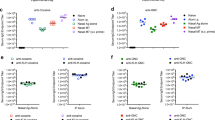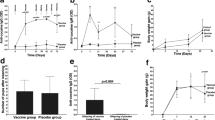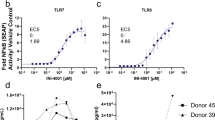Abstract
COCAINE is a powerfully addictive substance and new strategies are needed to treat its abuse. Generating an active immunization1,2 to cocaine offers a means of blocking the actions of the drug by preventing it from entering the central nervous system, and should have fewer side effects than treatments based on manipulation of central neurotransmitter function. The design and preparation of a cocaine immunogen requires special regard for the stability of cocaine both free and as a haptenic determinant. Immunochemistry and a well defined behavioural model were brought together to address the problem of inactivation of the psychostimulant actions of cocaine. We report here that active immunization with a new, stable cocaine conjugate suppressed locomotor activity and stereotyped behaviour in rats induced by cocaine but not by amphetamine. Moreover, following acute injection of cocaine, levels of cocaine in the striatum and cerebellum of the immunized animals were lower than those of control animals. These results suggest that immunopharmacotherapy may be a promising means by which to explore new treatments for cocaine abuse.
This is a preview of subscription content, access via your institution
Access options
Subscribe to this journal
Receive 51 print issues and online access
$199.00 per year
only $3.90 per issue
Buy this article
- Purchase on Springer Link
- Instant access to full article PDF
Prices may be subject to local taxes which are calculated during checkout
Similar content being viewed by others
References
Spector, S., Berkowitz, B., Flynn, E. J. & Peskar, B. Pharmac. Rev. 25, 281–291 (1973).
Berkowitz, B. & Spector, S. Science 178, 1290–1292 (1972).
Garrett, E. R. & Seyda, K. J. pharm. Sci. 72, 258–271 (1983).
Stewart, D. J., Inaba, T. & Kalow, W. Clin. Pharmac. Ther. 25, 464–468 (1979).
Cunningham, K. A. & Lakoski, J. M. Neuropsychopharmacology 3, 41–50 (1990).
Matsubara, K., Kagawa, M. & Fukui, Y. Forensic Sci. Int. 26, 169–180 (1984).
Taussig, M. J. Curr. Top. Microbiol. Immun. 60, 125–174 (1973).
Misra, A. L. et al. Res. Commun. Chem. Path. Pharmac. 13, 579–584 (1976).
Bagasra, O., Forman, L. J., Howeedy, A. & Whittle, P. Immunopharmacology 23, 173–179 (1992).
Gallacher, G. Immunopharmacology 27, 79–81 (1994).
Kelly, P. H. & Iversen, S. D. Eur. J. Pharmac. 40, 45–56 (1976).
Lyon, M. & Robbins, T. W. in Current Developments in Psychopharmacology Vol. 2, 89–163 (eds Essman, W. & Valzelli, L.) (Spectrum, New York, 1975).
Minden, P. & Farr, R. S. in Handbook of Experimental Immunology (ed. Weir, D. M.) 463–492 (Davis Co., Philadelphia, 1967).
Steward, M. W. & Steensgaard, J. Antibody Affinity: Thermodynamic Aspects and Biological Significance (CRC Press, Boca Raton, FL, 1983).
Eisen, H. N. (ed.) in Methods in Medical Research 106–114 (Year Book Medical Publishers, Chicago, 1964).
Hill, J. H., Wainer, B. H., Fitch, F. W. & Rothberg, R. M. Clin. exp. Immun. 15, 213–224 (1973).
Benuck, M., Lajtha, A. & Reith, M. E. A. J. Pharmac. exp. Ther. 243, 144–149 (1987).
Ritz, M. C., Lamb, R. J., Goldberg, S. R. & Kuhar, M. J. Science 237, 1219–1223 (1987).
Fischman, M., Schuster, C. R. & Hitano, Y. Pharmac. Biochem. Behav. 18, 123–127 (1983).
Javaid, J., Fischman, M. W., Schuster, C. R., Dekirmenjian, H. & Davis, J. M. Science 202, 227–228 (1978).
Landry, D. W., Zhao, K., Yang, G. X.-Q., Glickman, M. & Georgiadis, T. M. Science 259, 1899–1901 (1993).
Gold, L. H. & Koob, G. F. Pharmac. Biochem. Behav. 29, 645–648 (1988).
Fray, P. J. et al. Psychopharmacology 69, 253–259 (1980).
Robbins, T. W. in Handbook of Psychopharmacology (eds Iversen, L., Iversen, S. & Snyder, S.) 37–82 (Plenum, New York, 1977).
Kullback, S. Information Theory and Statistics (Dover, New York, 1968).
Kelly, P. H., Seviour, P. W. & Iversen, S. D. Brain Res. 94, 507–522 (1975).
Author information
Authors and Affiliations
Rights and permissions
About this article
Cite this article
Carrera, M., Ashley, J., Parsons, L. et al. Suppression of psychoactive effects of cocaine by active immunization. Nature 378, 727–730 (1995). https://doi.org/10.1038/378727a0
Received:
Accepted:
Issue Date:
DOI: https://doi.org/10.1038/378727a0
This article is cited by
-
The M3-TT Vaccine Decreases the Antinociceptive Effects of Morphine and Heroin in Mice
International Journal of Mental Health and Addiction (2023)
-
Novel mucosal adjuvant, mastoparan-7, improves cocaine vaccine efficacy
npj Vaccines (2020)
-
Ethical Implications in Vaccine Pharmacotherapy for Treatment and Prevention of Drug of Abuse Dependence
Journal of Bioethical Inquiry (2018)
-
Novel Cocaine Vaccine Linked to a Disrupted Adenovirus Gene Transfer Vector Blocks Cocaine Psychostimulant and Reinforcing Effects
Neuropsychopharmacology (2012)
-
Vaccines targeting drugs of abuse: is the glass half-empty or half-full?
Nature Reviews Immunology (2012)
Comments
By submitting a comment you agree to abide by our Terms and Community Guidelines. If you find something abusive or that does not comply with our terms or guidelines please flag it as inappropriate.



